View in other NatureServe Network Field Guides
NatureServe
Montana
Utah
Wyoming
Idaho
Wisconsin
British Columbia
South Carolina
Yukon
California
New York
A Crustose Lichen - Lecanoropsis iapyx
Native Species
Global Rank:
GNR
State Rank:
S4
(see State Rank Reason below)
Agency Status
USFWS:
USFS:
BLM:
External Links
State Rank Reason (see State Rank above)
Lecanoropsis iapyx was recognized as a new species in 2025 (Ivanovich et al. 2025). The Type specimen used to describe the species comes from a locality in Mussellshell County, Montana (Ivanovich et al. 2025). Lecanoropsis iapyx has been found in at least six states in the western United States of America. As of 2025, it is known from five counties in Montana. More locations in other states and Montana counties are expected to be found. Lecanoropsis iapyx is considered to be widespread and common, growing on natural and manmade substrates, and in habitats that vary from lowly to highly disturbed. As of 2025, threats are not known. Consequently, Lecanoropsis iapyx is considered to be more secure in Montana than observation records, and the calculated State Rank might indicate, and is assigned a Conservation Status Rank of S4. Surveys are needed to assess its true distribution and population size in Montana.
General Description
GROWTH FORM: Crustose
THALLUS: Often not present or is poorly developed. When present thallus mainly grows within the wood (endosubstratal: upper lithocortex of fungal hyphae and wood, central layer of algae, and lower layer of fungal hyphae embedded in the wood). When present, the thallus occurs around apothecia, is smooth to verrucose, and beige to dark brown. Source: Ivanovich et al. 2025
PHOTOBIONT: Green algal - in the genera
Chlorococcum or
Trebouxia. Algal layer appears brighter-green. Source: Ivanovich et al. 2025
REPRODUCTIVE TYPE: Apotheciate.
Apothecia very abundant, sometimes completely covering the substrate; round, sometimes deformed shaped, normally sessile, rarely appressed, and (0.45-)0.50 – 0.67(-0.70) mm in diameter.
Apothecial Disc is flat to weakly convex, ochre to reddish or dark brown, rarely weakly glossy, and typically not pruinose (epruinose); it is uncommon to have a fine to coarse white pruina.
Apothecial Margin is whitish greyish to slightly darkening into beige. When young, the margin is thick, raised, and smooth to subrugose. When older, the margin may unevenly recede and form warts, becomes thinner, subrugose, and is (0.02-)0.04-0.08(-0.12) mm wide. Source: Ivanovich et al. 2025
CHEMICAL REACTIONS: Chemicals are applied to cross-sections of the hymenial layer under a compound microscope. In water, epihymenial pigment color is hyaline to faint golden-brown to brown.
* Potassium hydroxide (KOH; K) reaction turns to orange-brown; a subsequent application of hydrochloric acid (HCl) turns to faint orange; another subsequent application of K turns yellow-orange to brown.
* Nitric acid (HNO3; N) reaction turns to orange-red; subsequent application of K turns to yellow-orange; subsequent application of HCl turns to faint orange; another subsequent application of K turns yellow-orange to brown. Source: Ivanovich et al. 2025
TAXONOMY & NOMENCLATUREA systematic revision of the
Lecanora saligna-group led to the resurrection of
Lecanoropsis M. Choisy ex Ivanovich and descriptions for 23 species, of which 6 are new to science (Ivanovich et al. 2025). The revision is based on morphology and a phylogenetic analysis using 7 loci.
Lecanoropsis iapyx was determined to be a new species to science. The formal description of this new species is based on the specimen (type) collected in Montana in 2016. Previously, specimens were lumped with
L. saligna.
Lecanoropsis was originally described by Choisy in 1949, stating that the lichen “differs from the current genus
Lecanora subgenus
Eulecanora by the ovoid-oblong, straight or sometimes slightly curved pycnoconidia”. Into
Lecanoropsis Choisy lumped
Lecanoropsis saligna and three other species. However, Choisy’s work was considered invalid because the formal diagnosis was only provided in French; that is, the proper protocol for naming species was not followed. The recognition of
Lecanoropsis M. Choisey was ignored until 1984. Hafellner (1984) doubted the validity of this ‘new’ genus, but applied the name to specimens he named
Lecanoropsis saligna (Schrader) M. Choisy (lectotype). Hafellner (1984) stated that the pycnidia of
Lecanoropsis saligna should be re-evaluated to determine if they truly differ from
Lecanora s. str. in shape and size. In 2019, studies by Kondratyuk et al. put additional species into
Lecanoropsis but failed to provide a formal description. Studies by Ivanovich et al. (2025) concluded that
Lecanoropsis does warrant recognition based on molecular evidence and phenotypic traits, and chose to resurrect and properly describe the genus, and its members of species.
The specific epithet of
iapyx is the name of a minor Greek wind god of the north-west or west-north-west wind (Ivanovich et al. 2025;
Wikipedia 2025). The name refers to the lichens’ position within its distributional area of western North America (Ivanovich et al. 2025).
Diagnostic Characteristics
A Taxonomic Revision of the Lichen Genus Lecanoropsis (Lecanoraceae) by Ivanovich et al. (2025) should be consulted to identify the species and related taxa. This publication provides a dichotomous key for Lecanoropsis, detailed descriptions, photographs, and other information.
Lecanoropsis iapyx has a thallus that is typically endosubstratal; an apothecial disc of ochre to dark brown color and is flat to weakly convex; an apothecial margin that is whitish, thick, and becoming unevenly excluded, but persistent in old apothecia; macroconidia are reniform; and the thallus produces isousnic acid (Ivanovich et al. 2025).
Lecanoropsis iapyx is similar to Lecanoropsis saligna, a European species (Ivanovich et al. 2025). They differ in their conidia shape, by an epihymenial pigment reaction, and chemistry. The conidia in Lecanoropsis iapyx are reniform macroconidia with obtuse tips. The conidia in Lecanoropsis saligna are crescent-shaped with acute tips.
Range Comments
Lecanoropsis iapyx has been found in the western USA, including Arizona, California, Colorado, Oregon, Montana, and Nevada (Ivanovich et al. 2025; Hollinger personal communication). In the Pacific Northwest and east of the Cascades Lecanoropsis iapyx is considered to be the more common species in the genus Lecanoropsis (McCune personal communication).
The physical specimen used to formally describe the new species (type specimen) by Ivanovich et al. in 2025 was collected in Musselshell County, Montana in 2016. Lecanoropsis iapyx is known to occur in Jefferson, Glacier, Lake, Musselshell, and Sheridan counties in Montana.
Observations in Montana Natural Heritage Program Database
Number of Observations: 6
(Click on the following maps and charts to see full sized version)
Map Help and Descriptions
Relative Density
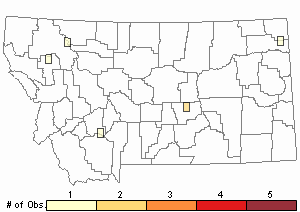
Recency
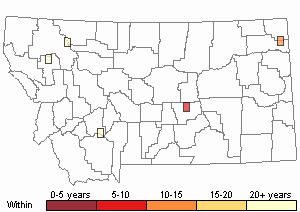
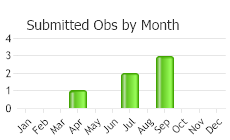
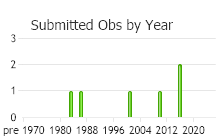
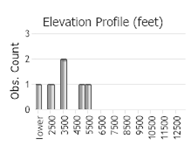 (Observations spanning multiple months or years are excluded from time charts)
(Observations spanning multiple months or years are excluded from time charts)
Habitat
Lecanoropsis iapyx grows in habitats and on substates that are commonly found across its range. Lecanoropsis iapyx is commonly found in oak and pine woodlands of semi-open areas and at elevations from 2625 to 8202 feet above sea level (800 and 2500 meters) (Ivanovich et al. 2025). Consistent factors across its range appear to be abundant light and aridity (Hollinger personal communication). In Montana, the Type specimen of Lecanoropsis iapyx was found within a Ponderosa Pine-Juniper woodland with calcareous sandstone outcrops, and on conifer wood of trees situated within a ravine.
Lecanoropsis iapyx grows on substrates of oak and conifer wood that is stripped of bark (lignicoloeus), wooden planks, and fence posts (Ivanovich et al. 2025), and also wood of logs, snags, and stumps (Hollinger personal communication). The settings where Lecanoropsis iapyx occurs ranges from pristine, wild and natural areas to highly disturbed, manmade habitats. Suitable substrates are found in open woodlands, grasslands, chaparral, and possibly prairies (Hollinger personal communication). In Montana, it has been found growing on juniper wood in open native woodlands, on fence posts within native grassland, and on wooden porch steps in a mesic forest opening. In Oregon, lichens were found on fence posts in heavily grazed open pastures (Ivanovich 2025). In Colorado, they were found growing abundantly on a fallen tree within a highly disturbed, urban setting (Hollinger 30302; Hollinger personal communication). In California and Nevada, populations were found on substates along roads, including a dirt road, and in a site that is grazed (Hollinger personal communication).
Ecology
CHEMICAL COMPOUNDS
Lichens produce primary and secondary chemical compounds that provide a variety of essential and specialized roles (McCune and Geiser 2023). Readers are encouraged to consult Nash (1996) and McCune and Geiser (2023) for more information.
Major compound found in Lecanoropsis iapyx is isousnic acid (Ivanovich et al. 2025). Lichenic crystals were found to dissolve in KOH, indicating crystals are made of a secondary metabolite (isousnic acid for Lecanoropsis iapyx).
Reproductive Characteristics
Sexual and asexual reproduction of the fungus occurs by macroconidia and spores produced from an apothecium.
SYMBIOTIC PROPAGULES
Conidium (-ia, plural) are found in some types of fungi; a spore produced asexually at the tip of a specialized hypha (-ae, plural) (Budel and Scheidegger in Nash [ed.] 1996). Lecanoropsis iapyx produces conidia on specialized hyphae within pycnidia, which are embedded flask-shaped structures. Type of conidia produced are macroconidia, reniform in shape and 7-8.5 by 1.5-3 micrometers; other types of conidia are not known for Lecanoropsis iapyx (Ivanovich et al. 2025).
GENERATIVE REPRODUCTION
Apothecia are disk-shaped fruiting bodies which hold the production of spores, from sexual reproduction of the fungus (Budel and Scheidegger in Nash [ed.] 1996). For technical guidance on identifying Lecanoropsis iapyx, readers should consult the full publication by Ivanovich et al. 2025. The margin of the apothecium (amphithecium) is usually filled with algae and interspersed with golden-brown granules. The amphithecium cortex is under-developed, sometimes without cortex, and moderately gelatinized, (8-)11-20(-28) micrometers laterally wide, (8-)13-20(-28) micrometers basally side, hyaline. The parathecium is not distinguishable. Epihymemium is usually golden-brown possibly containing Leptocline-brown; usually with thick epipsamma of golden-brown granules that dissolve in KOH; rarely hyaline. Hymenium is hyaline, heavily inspersed with golden granules (35-)40-5(-55) micrometers. Subhymenial layer [subhymenium plus hypothecium] is hyaline, (65-)95-135(-155) micrometers. Paraphyses rarely branching and anastomosing, segments short and stout in appearance, about 1.5-1.7 micrometers wide; apices not to weakly capitate, 1.7-1.7 micrometers; and apical gel sheaths, about 3.5 micrometers wide.
Spores ellipsoid, simple, hyaline (6.0)9.0-11.0(13.5) by (3.0)3.5-4.0(4.5) micrometers.
Management
TYPE SPECIMENNew botanical species are named and described based on a single specimen, which is designated as the name-bearing "type" and preserved in an herbarium. The species is formally accepted when named and described in a scientifically recognized publication. The specimen collected by lichenologist Bruce McCune in 2016 on a private ranch in Mussellshell County, Montana is the Type specimen used by Cristóbal Ivanovich to formally describe
Lecanoropsis iapyx (Ivanovich et al. 2025). In 2016, McCune also collected a second, duplicative specimen. The duplicate collection is referred to as the "isotype specimen" and is preserved at the
University of Montana Herbarium (MONTU), Missoula, Montana.
Stewardship Responsibility
Threats or Limiting Factors
As of 2025, there are no known threats to the populations in Montana.
References
- Literature Cited AboveLegend:
 View Online Publication
View Online Publication Büdel B. and Scheidegger C. 1996. Thallus morphology and anatomy; in Nash, TH, III (ed.) Lichen Biology. Cambridge University Press, Cambridge. 303 pp.
Büdel B. and Scheidegger C. 1996. Thallus morphology and anatomy; in Nash, TH, III (ed.) Lichen Biology. Cambridge University Press, Cambridge. 303 pp. Choisy, M. 1949. Catalogue des lichens de la region Lyonnaise. Fascicle. 2. Bulletin de la Societe Linneenne de Lyon 18: 137-152.
Choisy, M. 1949. Catalogue des lichens de la region Lyonnaise. Fascicle. 2. Bulletin de la Societe Linneenne de Lyon 18: 137-152. Hafellner, J. 1984. Studien in Richtung einer naturlicheren Gliederung der Sammelfamilient Lecanoraceae und Lecideaceae. In: Hertel, H. & Oberwinkler, F. (eds.) Beitrage zur Lichenologie. Festschrift J. Poelt. Beihefte zur Noval Hedwigia 79: 241-371.
Hafellner, J. 1984. Studien in Richtung einer naturlicheren Gliederung der Sammelfamilient Lecanoraceae und Lecideaceae. In: Hertel, H. & Oberwinkler, F. (eds.) Beitrage zur Lichenologie. Festschrift J. Poelt. Beihefte zur Noval Hedwigia 79: 241-371. Hollinger, J. 2025. Personal communication on Lecanoropsis iapyx distribution and ecology. April 9-October 16. Electronic mail correspondence with Andrea Pipp, MTNHP, Helena, Montana.
Hollinger, J. 2025. Personal communication on Lecanoropsis iapyx distribution and ecology. April 9-October 16. Electronic mail correspondence with Andrea Pipp, MTNHP, Helena, Montana. Ivanovich, C., Weber, L., Palice, Z., Hollinger, J., Otte, V., Sohrabi, M., Sheehy, S., and Printzen, C. 2025. A Taxonomic Revision of the Lichen Genus Lecanoropsis (Lecanoraceae). Phytotaxa 695(1): 001-056.
Ivanovich, C., Weber, L., Palice, Z., Hollinger, J., Otte, V., Sohrabi, M., Sheehy, S., and Printzen, C. 2025. A Taxonomic Revision of the Lichen Genus Lecanoropsis (Lecanoraceae). Phytotaxa 695(1): 001-056. Kondratyuk, S.Y., Lokos, L., Jang, S.-H., Hur, J.-S. and Farkas, E. 2019. Phylogeny and taxonomy of Polyozosia, Sedelnikovaea and Verseghya of the Lecanoraceae (Lecanorales, lichen-forming Ascomycota). Acta botanica Hungarica 61: 137-184.
Kondratyuk, S.Y., Lokos, L., Jang, S.-H., Hur, J.-S. and Farkas, E. 2019. Phylogeny and taxonomy of Polyozosia, Sedelnikovaea and Verseghya of the Lecanoraceae (Lecanorales, lichen-forming Ascomycota). Acta botanica Hungarica 61: 137-184. McCune, B. 2025. Personal communication regarding Lecanoropsis iapyx occurrences, distribution, abundance. October 15-16. Electronic mail correspondence between Bruce McCune, OSU, Corvallis, Oregon and Andrea Pipp, MTNHP, Helena, Montana.
McCune, B. 2025. Personal communication regarding Lecanoropsis iapyx occurrences, distribution, abundance. October 15-16. Electronic mail correspondence between Bruce McCune, OSU, Corvallis, Oregon and Andrea Pipp, MTNHP, Helena, Montana. McCune, B. and Geiser, L. 2023. Macrolichens of the Pacific Northwest. Third Edition, Revised and Expanded. Oregon State University, Corvallis, Oregon.
McCune, B. and Geiser, L. 2023. Macrolichens of the Pacific Northwest. Third Edition, Revised and Expanded. Oregon State University, Corvallis, Oregon. Nash, TH, III (Ed.). 1996. Lichen Biology. Cambridge University Press, Great Britain. 303 pp.
Nash, TH, III (Ed.). 1996. Lichen Biology. Cambridge University Press, Great Britain. 303 pp.
- Additional ReferencesLegend:
 View Online Publication
View Online Publication
Do you know of a citation we're missing? McCune, B. 2017. Microlichens of the Pacific Northwest. Volume 1: Key to the Genera. Wild Blueberry media, Corvallis, Oregon, USA iv+215 pages.
McCune, B. 2017. Microlichens of the Pacific Northwest. Volume 1: Key to the Genera. Wild Blueberry media, Corvallis, Oregon, USA iv+215 pages. McCune, B. 2017. Microlichens of the Pacific Northwest. Volume 2: Keys to the Species. Wild Blueberry Media, Corvallis, Oregon, USA iv+755 pages.
McCune, B. 2017. Microlichens of the Pacific Northwest. Volume 2: Keys to the Species. Wild Blueberry Media, Corvallis, Oregon, USA iv+755 pages. McCune, B., Rosentreter, R., Spribille, T., Breuss, O., and Wheeler, T. 2014. Montana Lichens: An Annotated List. Monographs in North American Lichenology, Volume 2, Northwest Lichenologists, Corvallis, Oregon.
McCune, B., Rosentreter, R., Spribille, T., Breuss, O., and Wheeler, T. 2014. Montana Lichens: An Annotated List. Monographs in North American Lichenology, Volume 2, Northwest Lichenologists, Corvallis, Oregon.
- Web Search Engines for Articles on "A Crustose Lichen"





